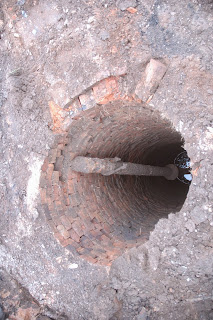We first met Vera Hallett and her cousin Christine Rea when
they came on one of the site tours on a very wet day in May. After visiting the
exhibition at Tudor House, they came into the Hive to talk about some of their
memories of Lich Street.
Vera was born at 15 Lich Street in the 1940s, later moving
to 1 house No 2 Court where she lived until she moved from Lich Street in 1955.
Christine moved from the area when she was three, but often visited her cousin
and remembers the street well.
Number 15, opposite the Punch Bowl Inn, was a large house
separated into rooms and occupied by several families who shared a kitchen and
a toilet. Vera's neighbours included Mrs
Dalton, Mr and Mrs Perry, Mr and Mrs Butcher who ran a boarding house for
homeless people as well as Mrs Butcher's brother Arthur Abbott, the chimney
sweep who we found recorded in the archives and looked at in an earlier blog
post.
Vera and Christine told us that there was no running hot
water and they had to wash in cold water in a shared sink. They remembered that
each family had an allocated wash day when their father would light the fire
under a big boiler to heat the water, whites were always washed first, then the
coloureds and the girls would come home from school at lunchtime to find lines
of washing in the yard or, if it was wet hanging, in the kitchen steaming up
the whole house. Across their backyard, where they had to go for a wash and to
the toilet, was a flat roof and from here they could look into the back yard of
Mr Holt the butcher who had his shop on the Shambles. Vera and Christine
remembered that, like a lot of the butchers in the street, he used his backyard
to slaughter the animals he sold in the shop.
Although the buildings were derelict and they remembered
cockroaches in the houses, Vera and Christine felt there was a sense of
community in the street and neighbours helped each other, particularly in times
of trouble.

















































